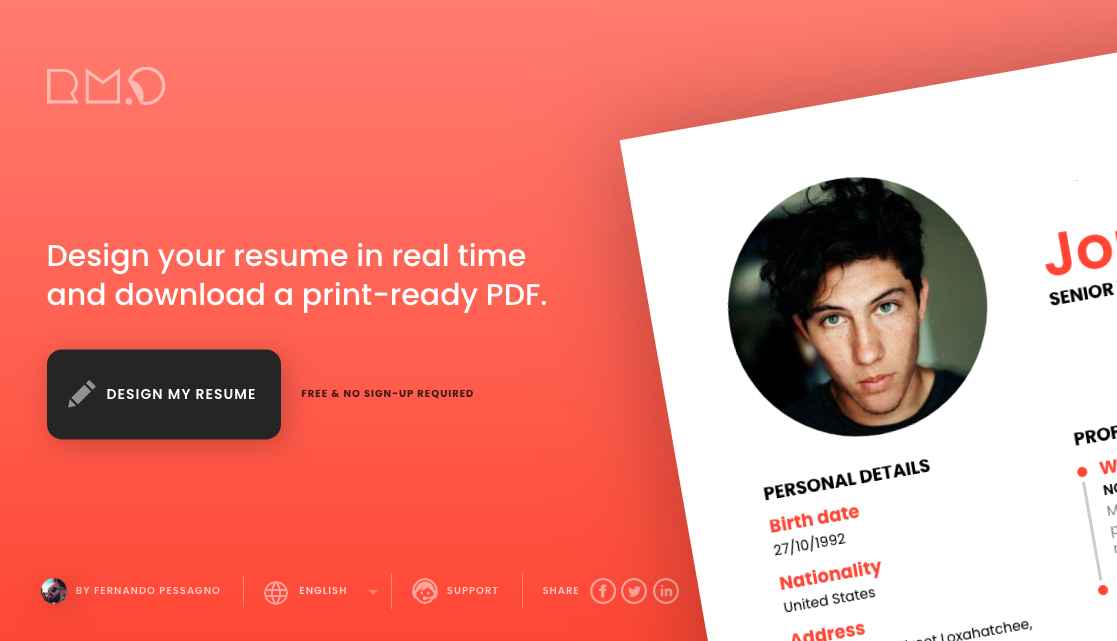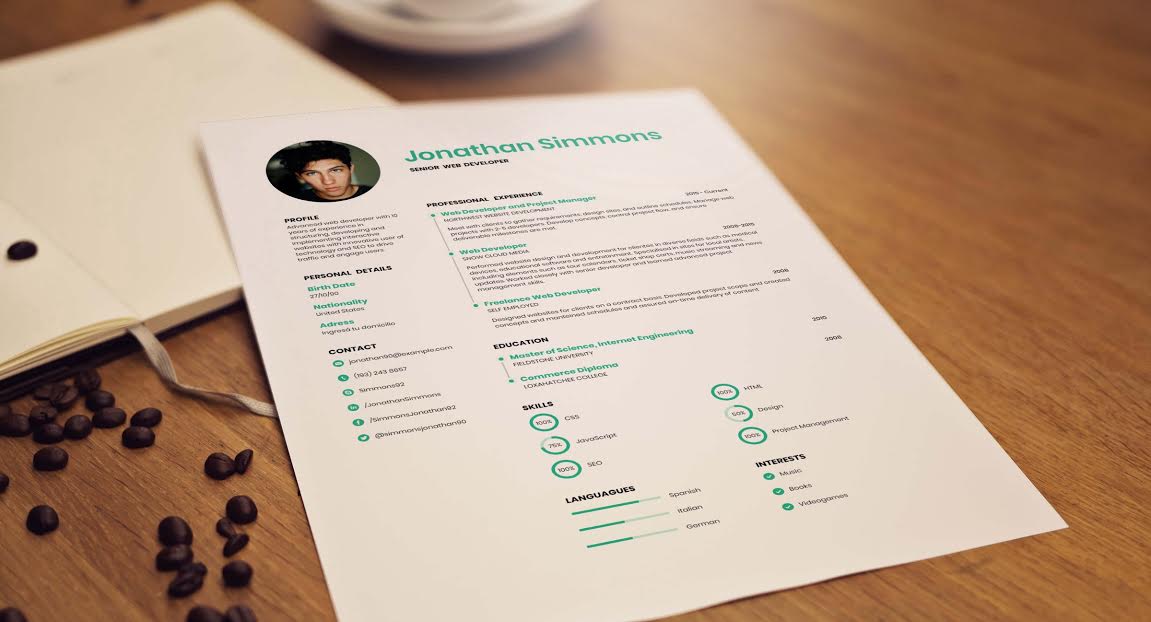COVID-19 pushed him to charge for his product. Here's why it worked.

In August 2018, with low expectations, Fernando Pessagno (@Fer_Momento) posted ResumeMaker.Online ($1,000/mo) on Product Hunt. To his total shock, it finished number one for the day and week. Not only that, but the successful launch spurred an avalanche of early growth.
In ResumeMaker's first month alone, more than 20,000 resumes were downloaded from more than 100 countries, along with countless shares and tweets.
The product idea
The project started in January 2018 when Fernando Pessagno's sister asked him for help with a problem everyone has eventually: designing a resume. Yet Fernando, an Argentinian UX designer who's been making websites since the Geocities days, couldn't find an online resume builder tool that would help his sister stand out.
There were plenty of resume builder webapps, sure. But they were all either user-unfriendly or looked unpolished and unprofessional, or both.
Fernando had been itching to build something new for a while, but not just anything — he wanted to make something that had the playfulness and challenge of the sites he built for fun as a teenager. But he also wanted what he built to be meaningful — a resume maker that would help people look their best and stand out from the sea of generic designs.
That was the germ of ResumeMaker.Online, a straightforward web app for not-so-tech-savvy users to quickly design a beautiful resume.

Assessing the competition
His original aspirations were humble: he just wanted to have fun building a site, and hopefully help a few people out. No financial goals, no lofty dreams to go viral or buy a lamborghini.
With no one waiting on him, he could take all the time he pleased to build the app. As a result, Fernando often found himself baking in additional features like multiple layouts, tons of mix and match design options, and various ways to input the information, just because he could. But even as he built them, he wondered if he was making the same mistakes of other resume builders.
The other resume builder options missed the mark because they were either so complex that they were hostile to anyone but a designer, or they were so simplistic that they just looked awful. What was missing was something beautiful and simple. By putting in additional features because they were fun to build, he was helping himself, but not his users.
Still, this was only a hunch. Other than his sister, he had no users to test that idea. Until he had an MVP, he couldn't do any market testing. He created a deadline, one that unexpectedly would put him in touch with great potential users.
Backpack validation
A two-month-long trip backpacking across Europe had been in his planner for a while anyway, so Fernando made his departure into his deadline. That motivated him to get the work done in a timely manner.
The trip also proved to be an incredible proving ground for Fernando's concept. As he travelled, he struck up conversations with the denizens of the hostels he stayed in, floating his concept to see what they thought. It was an endless supply of free feedback from potential users, and it opened Fernando's eyes.
Not only was his hunch that users wanted the tool to be simple but attractive correct, he hadn't gone far enough. He needed to cut his array of layout options, limiting font and color options, and changing complex section choices into yes-or-no toggles. That left him with a tool that looked good while being truly basic, in order to avoid scaring off users who weren't comfortable with design.
"I had to be strict and ask myself: which of all possible features are going to add real value for the user?"
Launch day
Those insights proved powerful when he returned home to Argentina and launched the final version of the product, one stripped down to the core concept alone: a beautiful and super-simple resume creation tool; space to input your information and little else.

That launch was, of course, successful beyond his wildest dreams, boasting the aforementioned 20k downloads in the first month. This made early marketing easy, and aside from some SEO tweaking, Fernando didn't do much else.
Instead, he focused on support, adding seven different languages, including French, Spanish, and Swedish, though he says that 85% of traffic still goes to the English version.
"It's fair to assume that keeping the product 100% free for almost two years helped to keep a steady traffic growth by word of mouth."
The project that was meant to be nothing more than a side challenge was proving to be a more powerful concept than Fernando expected. But even though Fernando saw a money-making opportunity, he was too worried about getting in the way of growth. So he started with a fixed-value donation button, with options ranging from $1 to $20.
"This was the ultimate way of validating the product and, on top of that, a useful way to find out what could be the price most users will be willing to pay"
With this and a few affiliate links alone, Fernando happily kept the lights on for two years. Then he was approached with an opportunity to sell the site.
COVID-19 spoils the party
In fact, the sale was nearly closed in January 2020, until COVID-19 hit and the sale fell through. And then website traffic took a huge dip in February and March, and then several of Fernando's affiliates pulled out.
During the strict Argentinian lockdown, Fernando paused to reconsider his monetization strategy. He decided to switch from donations to freemium, introducing a "PRO" plan with higher resolutions and no watermarks for $2.95 per download.
Now boasting over 400 downloads per month, it was a huge success. Traffic recovered and is now at an all-time high, around 3,000 unique users daily, and upwards of 70,000 uniques per month.
"While working on it, earning money never crossed my mind. In retrospect, I think this undisturbed and humble approach to just try and design a useful product was key to avoiding frustration."
With numbers like that, if Fernando had decided to stay in Argentina, he could live comfortably off of ResumeMaker alone. But he now makes his home in Europe, commuting between Estonia and Sweden, where his girlfriend lives.
"I'm not going to lie and say I don't think about how cool it would be to move to Southeast Asia. I could easily lower my expenses and work only on my products from a hammock with a perfect tan and a drink in hand."
To facilitate that, he's kept his dayjob and it fuels his drive to generate multiple income sources to accomplish the European version of the indie hacker's dream scenario. To do that he plans to market more aggressively in 2021, and with a +10% monthly site growth, living off of ResumeMaker isn't a far-fetched goal.
We asked Fernando what advice he has to offer to other indie hackers just getting their feet wet. He told us that starting your own project is overwhelming for everyone, so not to let that discourage you. He underestimated himself constantly as he built, but that's what convinced him to keep his build small. To combat that feeling, approach your creation humbly, with realistic goals.

If you'd like to learn more about ResumeMaker.Online and connect with Fernando, you can find him here:

